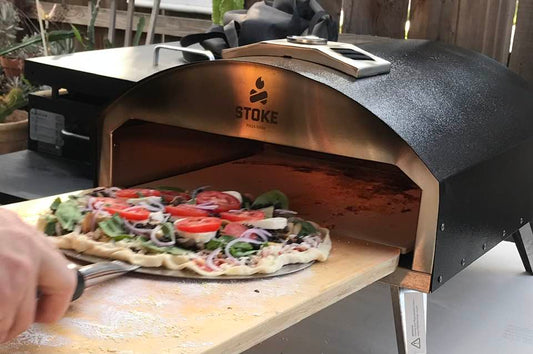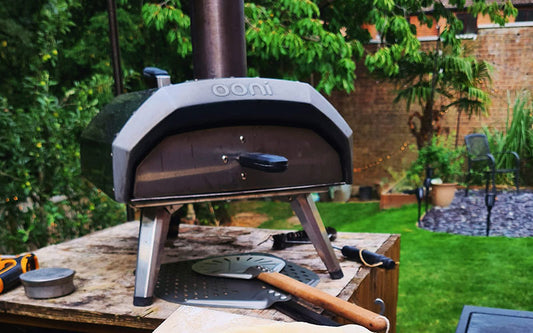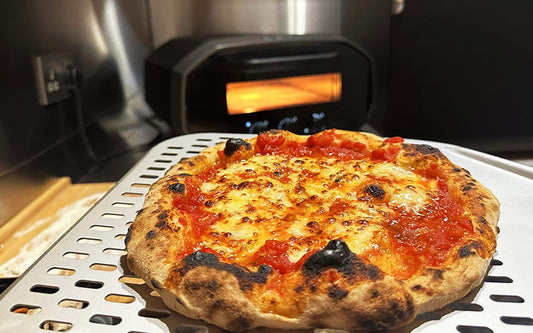There’s nothing more frustrating than slicing into a pizza only to have the toppings come sliding off in one big glop. The cheese stretched, the sauce smeared, and suddenly, your delicious creation is reduced to a hot mess. But fear not, pals, because I’m here to solve this sticky situation once and for all.
Pizza refusing to glide smoothly out of the pan is caused by a combination of factors. This includes a poorly prepared pan surface, overloading the pizza with toppings, and insufficient preheating. The solutions are easy. Properly season the pan and avoid overloading your pizza.
In this article, we’ll dive deeper into why pizza sticks to the pan and offer up a variety of tips and tricks to help you achieve the perfect, non-stick pizza every time. So grab a slice (or two) and read on because we’re about to get our hands (and pans) dirty.
Pizza Stuck to Pan? Here Are 5 Common Causes [And Their Equally Common Solutions!]
So, you just took your perfectly crafted pizza out of the oven, and instead of sliding out like a dream, it’s stuck to the pan! I’ve been there numerous times. And I assure you, this frustrating issue happens to even the most seasoned pizza makers. Let’s dive into the 5 most common causes of pizza sticking to the pan.
Reason #1: Use of Inadequate Cooking Spray or Oil
Not using enough oil means the dough will stick to the pan, and you’ll end up with a mess instead of a beautiful pizza. But don’t worry. It’s a fixable issue.
I remember the first time I made pizza at home. I was so excited to try it out but forgot to add enough oil to the pan. And you guessed it right, my pizza was stuck to the pan! It was a lesson learned the hard way, but one that you can avoid.
Solution:
Just make sure to use enough cooking spray or oil to create a barrier between the pan and the dough. A thin coating will do the trick and ensure your pizza slides right out.
Reason #2: Insufficient Flour or Cornmeal on the Pan
Like oil, flour also creates a barrier between the dough and the baking surface, which prevents stickiness. Not using enough flour can also cause it to become misshapen and even tear when you try to remove it from the pan.
Solution:
The solution is simple. Use enough flour or cornmeal! When rolling out your dough, dust the pan generously with either flour or cornmeal before placing the dough on it. I personally prefer cornmeal because it adds a subtle crunch to the bottom of the crust, but either will work. The key is to make sure you use enough so that the dough doesn’t stick.
Reason #3: Overloading Pan With Toppings
Too many wet toppings like sauce, fresh mozzarella, mushroom, and juicy grilled meat can turn the flour into adhesive. Dripping cheese is basically liquid (albeit delicious) glue. Excess toppings can also weigh down the crust, causing it to tear apart when you’re removing it from the pan.
Solution:
So, be mindful of how much toppings you’re adding to your pizza. I recommend spreading the toppings evenly across the crust, leaving a little bit of space around the edges to help the crust rise and bake evenly.
Also, keep in mind that some toppings are heavier than others. For example, if you’re using a lot of vegetables or meats, it’s best to sauté or cook them first to reduce their moisture content and prevent them from weighing down your pizza.
Also, I always suggest preheating the pan in the oven for a few minutes before adding the toppings and dough. This helps the crust start to bake and set before it becomes overwhelmed by the weight of the toppings.
If you’re baking a thin-crust pizza with lots of toppings, I guarantee you will get better results if you pre-bake the crust before adding your toppings.
Reason #4: Using a Pan With a Non-stick Coating That Is Damaged or Worn Out
Using the right equipment is just as important as using the right ingredients when it comes to making a delicious pizza. One common mistake that many people make is using a pan with a damaged or worn-out non-stick coating.
When a non-stick coating is damaged or worn out, it loses its ability to provide a smooth, slippery surface for the pizza to glide on. As a result, the dough and toppings can start to stick to the pan, making it difficult to release the pizza from it.
Solution:
If you’re using a pan with a non-stick coating, make sure to be gentle when using utensils and cleaning it. Avoid using metal utensils that can scratch the surface and wash it by hand using a soft sponge or brush and non-abrasive cleaners.
If the non-stick coating is damaged, it’s time to invest in a new heavy-duty pan. You can also try using a pizza stone, pizza steel, or a well-seasoned cast iron pan for a crispy crust and hassle-free removal.
Reason #5: Not Preheating the Oven Properly
When you don’t preheat the oven enough, the pizza dough can start to bake before it has a chance to set and form a crust. This will not only make the crust stick to the pan but also affect the appearance, taste, and texture of the crust.
Solution:
Make sure you preheat your oven for at least 45 minutes before baking your pizza. This will give the oven enough time to reach the desired temperature.
I also suggest placing your cast iron or aluminum pan in the oven before you start preheating it. This will help the pan and oven reach the right temperature simultaneously, ensuring that the pizza bakes evenly.
5 Easy Solutions for Preventing Pizza from Sticking to Pan
So, in short, here are 5 rules to abide by to ensure your pizza slides out of the pan without any trouble:
- Generously season the pan with oil or cooking spray.
- Follow it up by dusting it with flour or cornmeal.
- Strain your fresh mozzarella, sautee your veggies, and use an appropriate amount of sauce to limit the moisture content on the dough. Also, spread the toppings evenly. If making an overloaded pizza, I strongly recommend pre-baking the dough.
- Ideally, you should use a well-seasoned cast iron skillet for baking pizza at home. If you are using a non-stick pan, make sure the non-stick coating is intact.
- Don’t forget to preheat your pan as well.
How to Remove Stuck Pizza from Pan
In the unfortunate event of your freshly baked pizza refusing to leave the pan, do the following:
Using a spatula or pie lifter as it allows you to safely and easily transfer the pizza to and from the oven without risking the crust sticking to the pan or being damaged. The spatula or pie lifter also provides a sturdy base to help support the weight of the pizza and toppings while you’re maneuvering it.
If the above solution doesn’t work, try soaking the pan in warm water for a few minutes. This can help loosen the stuck bits of a heavily stuck pizza because the heat and moisture can soften the crust and toppings, making it easier to remove them from the pan. This technique is especially useful if you’ve burned the pizza or if it’s been sitting in the pan for an extended period of time.
Related FAQs
Can I put pizza toppings before placing the dough on the pan?
It makes more sense (to me) to first put the dough on the pan and then add the toppings and not before.
Can extra cheese be the reason why my pizza sticks to the pan?
Extra moisture in your fresh mozzarella or the melted cheese dripping from the crust could make the pizza stick to the pan.
Can I use a silicone mat or parchment paper to prevent my pizza from sticking to the pan?
You can use parchment paper on your pizza pan. Just make sure to smear some oil and spritz it with cooking spray before placing your pizza dough on it.
The Bottom Line
In conclusion, there’s nothing more frustrating than a perfectly topped pizza that refuses to come off the pan. However, by understanding the common causes of pizza sticking, you can easily prevent it from happening in the future.
Whether you opt for a seasoned cast iron pan, a non-stick surface, or simply remember to lightly oil pan, and preheat it for an adequate amount of time. These solutions are sure to result in perfectly baked and perfectly sliceable pizzas every time!




